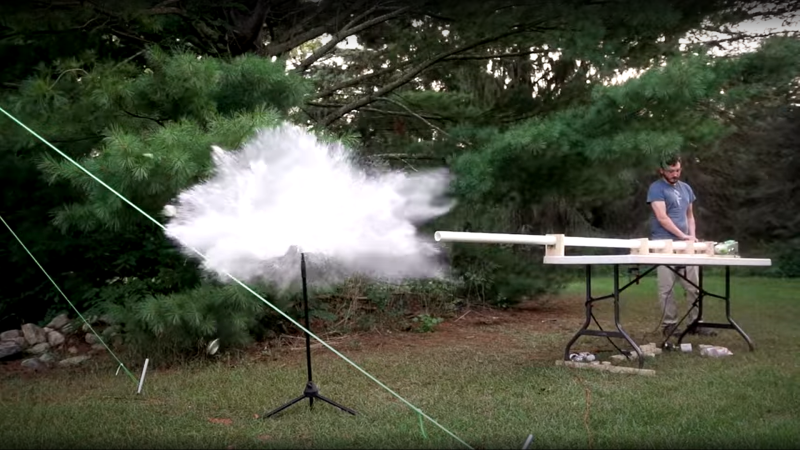[NightHawkInLight] has been developing his design for a vacuum canon for a while now, so it seems fitting to drop in check out the progress. The idea is pretty straightforward, take a long rigid tube, insert a close fitting piston, magnetically attached to a projectile, and stopper the open end with something easily destroyed. The piston needs to be pulled into the tube with some force, to pull a vacuum against the stopper. The interesting bit happens next, when the piston exits the other end of the tube, with the vacuum at its maximum, there is a sudden inrush of air. Apparently this inrush of supersonic velocity, and the momentum of the mass of air is sufficient to eject the projectile at considerable velocity, smashing through the plug and demolishing the target. So long as the target is of the soft and squishy variety anyway.
It’s an interesting idea, and certainly gives plenty of bang for not many bucks. That big lump of acrylic tubing (presumably used for ease of explanation in the video) looks fairly expensive to buy off the shelf, but we reckon any old pipe would probably work out fine.
We’ve definitely covered our share of DIY projectile weapons, like this air cannon made from PVC pipe parts, and of course there’s this crazy big one, that you should definitely not try at home.
Thanks [Keith] for the tip!

















Supersonic inrush? How can that be?
I’m sceptical. I’m pretty sure I heard him say that in the video, but I may be mistaken. Doesn’t make it true, mind.
I would think the speed of the air molecules would drop due to cooling on expansion plus there should be a shock wave boundary at the input.
But maybe he is talking about the speed of the fastest molecules in the distribution at the beginning which have no opposition. However I would guess there is not much of a vacuum as far as avoiding collisions with the remaining (cold) molecules in the tube. As you rise in the atmosphere of Earth speed of sound does not change with the pressure, only the temperature. The same should be true here.
The speed of the molecules has a Maxwell-Boltzmann distribution and a small number are at much higher speeds. The speed of sound is around 70% of the RMS speed of the molecules but that is not “many times the speed of sound”. You CAN pick a point in the distribution where a measurable percentage of the air is moving at a couple times mach 1. I suspect that is what he is talking about. He is usually pretty meticulous.
I haven’t watched the video yet, but by choking the flow through a de Laval nozzle
you can make the flow supersonic as happens in rocket engines. It converts thermal energy into coherent flow energy.
If it was you could have a mini ramjet on the front of the projectile that accelerated away from it even faster.
The mythbusters got supersonic speeds with a ping pong ball in Episode 215: Supersonic Ping Pong
Which had incredible speeds. They had 20 atmospheres of pressure and “vacuum” in a very long tube. Expanding into a vacuum I can see being faster than sound by around 30%, but where does the extra speed come from? The usual rules must come from ideal gas/adiabatic processes and this case is very far from that.
I do recall that when I was kid Boeing Research had a gas gun that used helium under pressure and could fire a good sized aluminum slug at 4km/sec. It used a double action process where a piston was fired by a small artillery shell in a cylinder that compressed the helium until a burst-diaphragm failed, and the projectile was on the other side of the diaphragm.
Maybe it is like the expansion of the universe where the gas is expanding in all regions at once and the speed of sound only has meaning locally.
I’m thinking of doing a vacuum tube launcher for a 3D printed model rocket held in a pool noodle split in half that fits with a bit of compression within the PVC pipe. The exhaust from the ignited motor would burst the rear closure instantly upon ignition and the rocket’s nose cone tip would burst the front one.
A muzzle velocity measurement would interesting to see. Assuming the projectile masses were the same, you could tweak the cannon design for max velocity. Different barrel diameters vs length would be informative. So would the value of a good seal on the front end, and around the piston. Even the shape of the end of the piston may make a difference (I noticed the piston had significant “throttling” length after the second O-ring was pulled clear of the barrel.)
It occurs to me the projectile may never touch the sealing cup at the front. There is likely enough air in the barrel (due to leaks) to cause the cup to be blown out of the barrel before the projectile even gets close.